The last of my einkorn flour was used to make this loaf. Einkorn hasn’t been easy to find, one of the places I used to go to for interesting flours has changed hands and the new owners are not selling as many varieties of flour anymore. Since einkorn is a very weak flour I use it in the tangzhong since in its preparation the proteins are denatured so any gluten potentially from the einkorn won’t contribute to the gluten structure of the final bread. As my usual, I use a stiff sweet levain to leaven this dough in order to avoid any sour tang that I find undesirable for these milk breads.
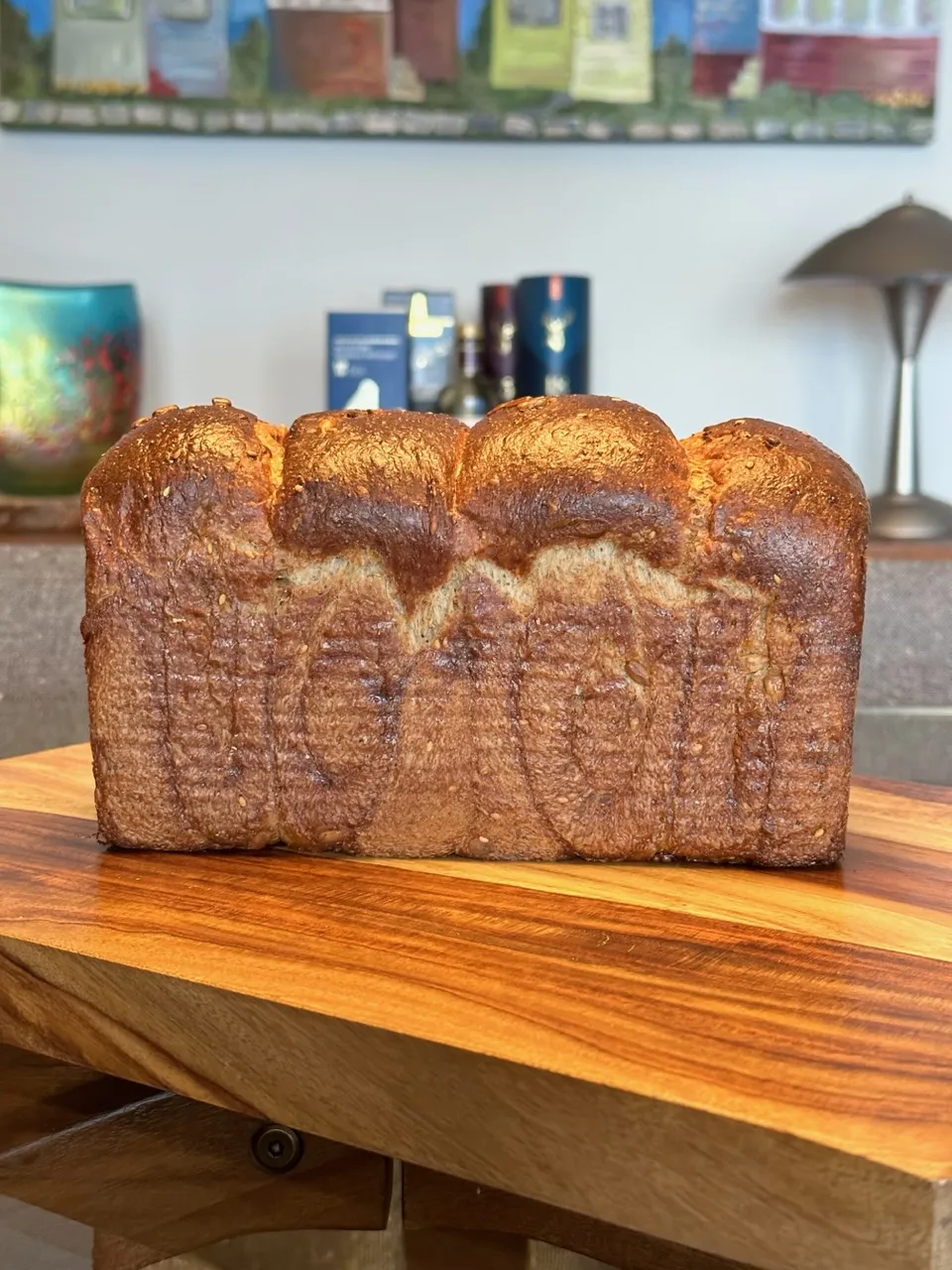
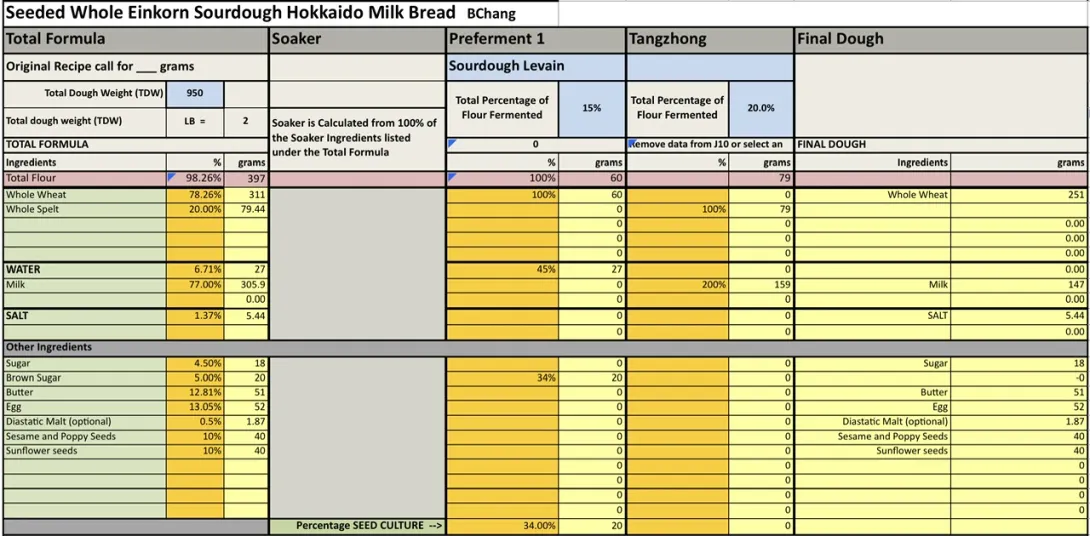
For one 9x4x4” Pullman pan loaf.
Instructions
Levain
Mix the levain ingredients in a jar or pyrex container with space for at least 300% growth.
Press down with your knuckles or silicone spatula to create a uniform surface and to push out air.
At a temperature of 76-78ºF, it typically takes up to 10-12 hours for this sweet stiff levain to be at peak. For my starter I typically see 3-3.5 times increase in size at peak. The levain will smell sweet with only a mild tang.
Tangzhong
In a sauce pan set on medium heat, stir the milk and whole wheat flour until blended. Then cook for several minutes until well thickened, stirring regularly with a spoon or heat-resistant spatula. Let cool in the pan or, for faster results, in a new bowl. Theoretically it should reach 65ºC (149ºF) but I don’t find I need to measure the temperature as the tangzhong gelatinizes at this temperature. You can prepare this the night before and refrigerate it, ensure that it is covered to prevent it from drying out.
If you plan on using a stand mixer to mix this dough, set up a Bain Marie and use your stand mixer’s bowl to prepare the tangzhong.
Dough
In the bowl of a stand mixer, add the milk (consider holding back 10 g of milk and adding later if this is the first time you’re making this), egg, tangzhong, salt, sugar and levain. Mix and then break up the levain into many smaller pieces. Next add the flour. I like to use my spatula to mix until there aren’t many dry areas. Allow the flour to hydrate (fermentolyse) for 20-30 minutes. Mix on low speed and then medium speed until moderate gluten development this may take 5-10 mins. You may want to scrape the sides of the bowl during the first 5 minutes of mixing. Next add room temperature butter one pat at a time. The dough may come apart, be patient, continue to mix until it comes together before adding in more butter. Again, knead until well incorporated. You will want to check gluten development by windowpane during this time and stop mixing when you get a good windowpane. You should be able to pull a good windowpane, not quite as good as a white flour because the bran will interrupt the windowpane somewhat. Add the seeds, then mix again until they are well distributed.
On the counter, shape the dough into a tight ball, cover in the bowl and ferment for 2 - 4 hours at 82ºF. There should be some rise visible at this stage.
You can next place the dough into the fridge to chill the dough for about 1.5 hours, this makes rolling the dough easier to shape. Remember, if you do so the final proof will take longer. Alternatively, you can do a cold retard in the fridge overnight, however, you may find that this increases the tang in your bread.
Prepare your pans by greasing them with butter or line with parchment paper.
Lightly oil the top of the dough. Scrape the dough out onto a clean counter top and divide it into four. I like to weigh them to have equal sized lobes. Shape each tightly into a boule, allow to rest 5 mins. Using an oiled rolling pin roll each ball out and then letterfold. Turn 90* and using a rolling pin roll each out to at least 8”. Letterfold again from the sides so you have a long narrow dough. Then using a rolling pin, roll flatter but keeping the dough relatively narrow. The reason to do this extra letterfold is that the shorter fatter rolls when placed in the pan will not touch the sides of the pan. This allows the swirled ends to rise during final proof, this is only done for appearance sake and is not necessary. Next roll each into a tight roll with some tension. Arrange the rolls of dough inside your lined pan alternating the direction of the swirls. This should allow a greater rise during proof and in the oven.
Cover and let proof for 4-6 hours at a warm temperature. I proof at 82°F. You will need longer than 4-6 hours if you chilled your dough for shaping. I proof until the top of the dough comes to within 1 cm of the top edge of the pan.
Preheat the oven to 350F and brush the dough with the egg-milk wash. Just prior to baking brush with the egg-milk wash again.
Bake the loaves for 50 minutes or until the internal temperature is at least 190ºF, rotating as needed to get even browning. Shield your loaf if it gets brown early in the baking process. After 50 mins remove the bread from the pan and bake a further 10 mins by placing the loaf directly in the oven on the rack with the oven turned down to 325ºF
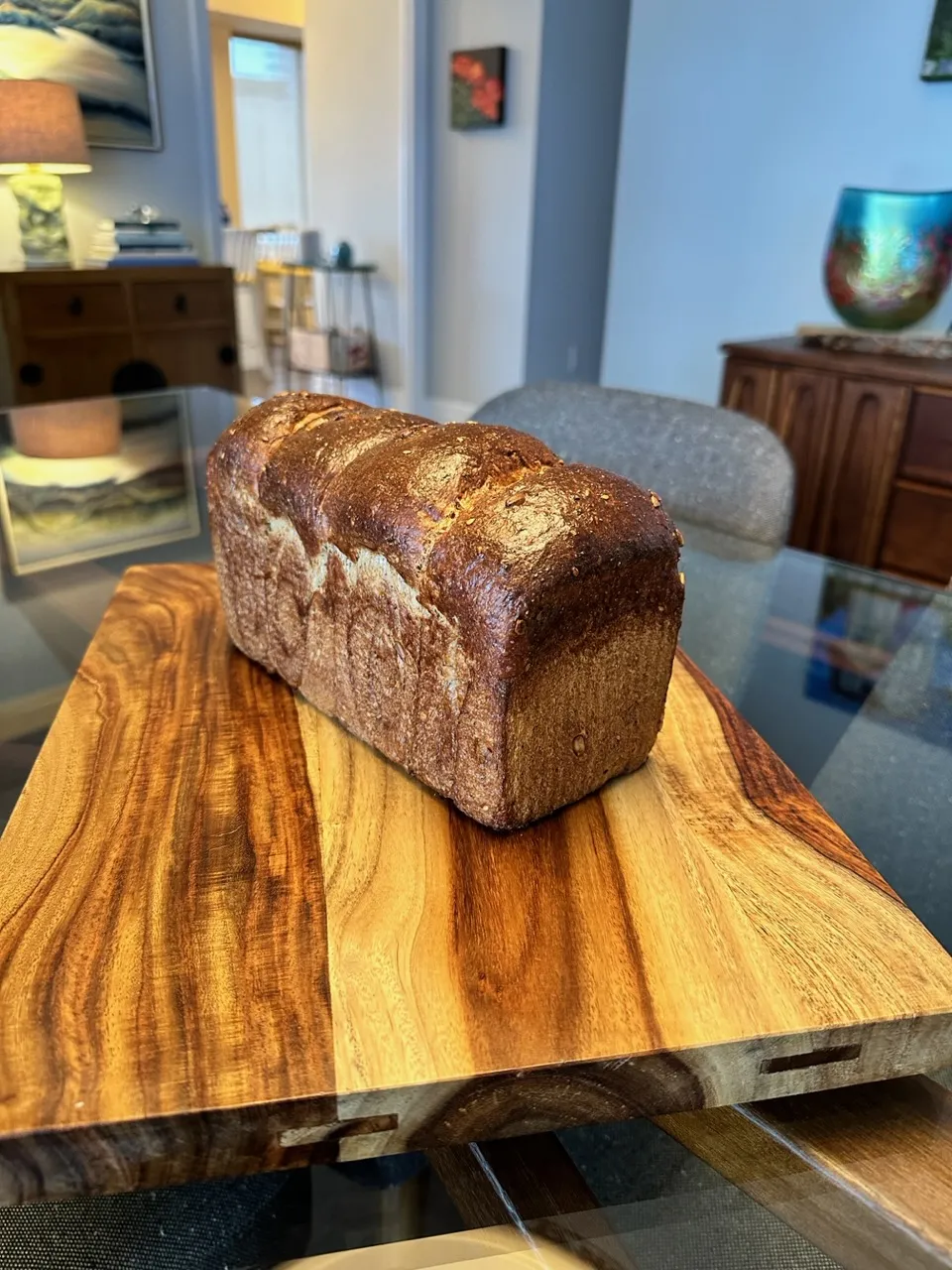
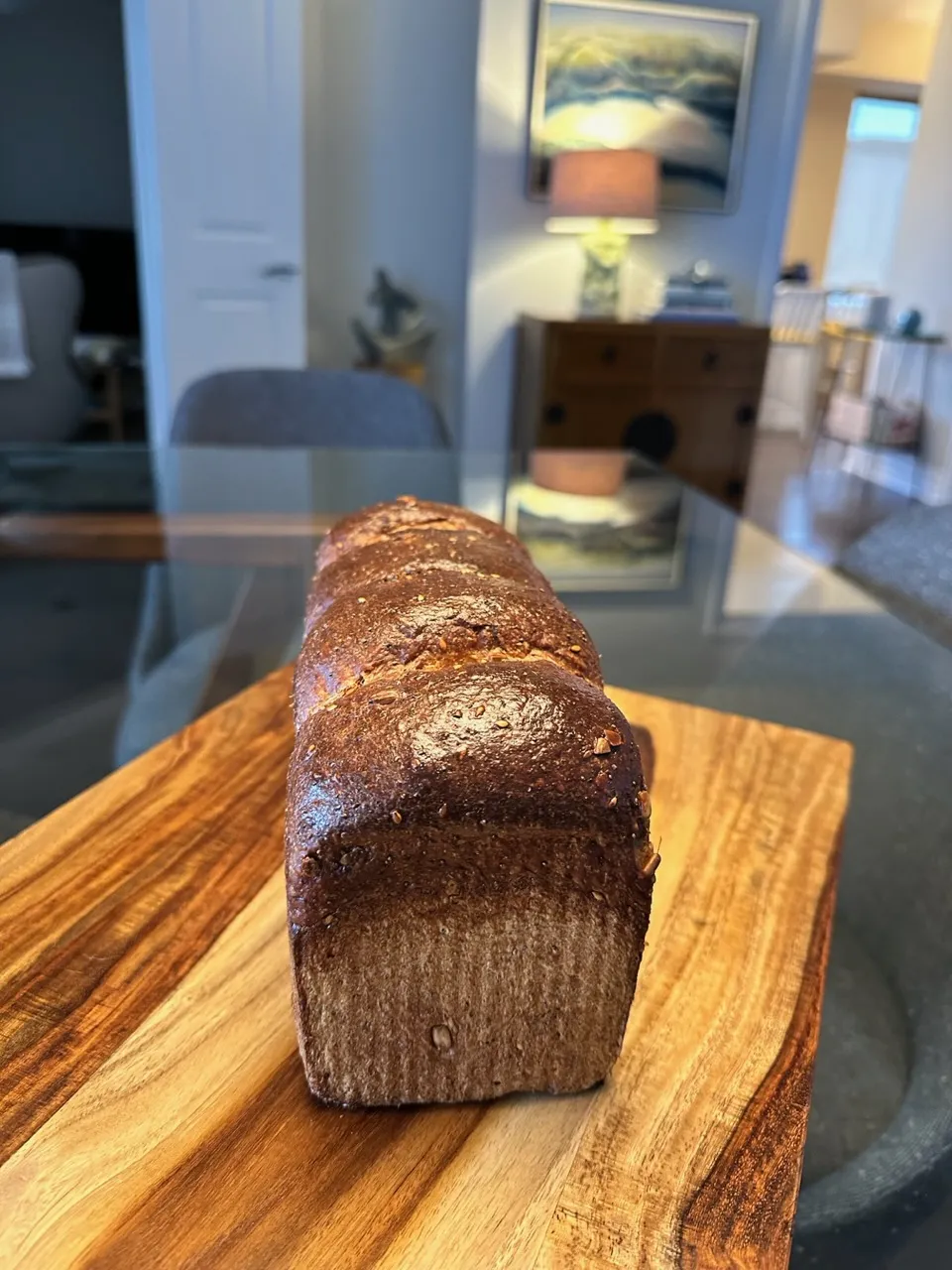
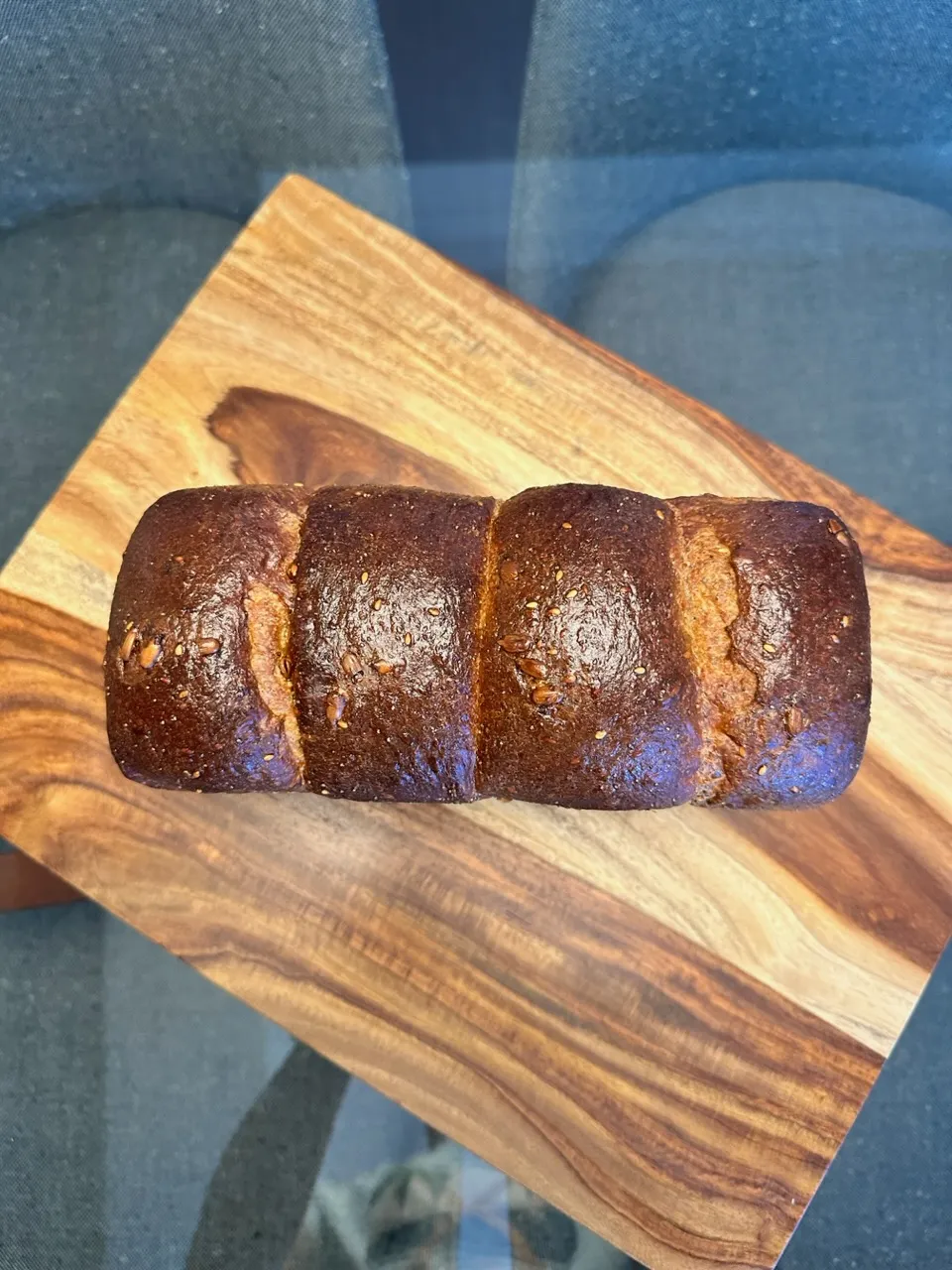
- Benito's Blog
- Log in or register to post comments
Lovely nutty flavour from the einkorn and wheat along with the various seeds. Nice and fluffy soft bread perfect for sandwiches and toast.
Benny, every time I see one of your posts (should I say your frequent posts), I think why doesn't this guy weigh 400 pounds? All of your bakes (breads, cakes, pies) are tremendous, and your photography is always excellent too. Thanks for all of your posts.
As for sourcing einkorn flour, have you ever gotten anything from Barton Springs? I haven't purchased any einkorn, but I am thinking of stocking up on rye from them and have also gotten spelt in the past. By the way, their Danko Rye is my favorite dark rye. For my next purchase I might get some einkorn along with the Danko Rye.
Happy baking.
Ted
Thank you for your kind comments Ted, much appreciated. Amazingly my weight is the same as it always has been pre and post starting to bake several years ago.
I’m in Canada and I believe Barton Springs to be in the US. It is exceedingly expensive to have things shipped from the US to Canada. I’ll keep my eyes out around here, I know Anita’s Organic Mills has Einkorn so I should be able to find it eventually. But thank you for the suggestion, I’ve heard great things about Barton Springs and also Central Mills.
Benny
This looks so delicious. Einkorn is my favorite- love it for its mild taste and slight yellow hue. Is it in the tangzhong only or main dough? I will likely try this out once I move (though every time I've made sourdough sandwich bread, its been too sour for me).
In the case of this bread, the einkorn is 20% of the total flour and only in the tangzhong. I hope you give this or any of my Hokkaido milk breads a try. By utilizing a stiff sweet levain it completely avoids the sour tang that I want to avoid in milk breads. Your starter needs to be up to snuff to make a stiff sweet levain, so make sure it is really active and healthy before building your levain or you will be disappointed.
Benny
i'll give it a go!!
Another beautiful bread, Benny. The crumb looks so ... artisanal
Best baking,
dw
Thank you so much Debra for your kind comments. I hope you’re enjoying the summer.
All the best
Benny
Einkorn is is one of my favorites as well. I'll bet the add-in seeds made for a nice texture and taste to the crumb. Another beautiful bake.
Tony
Thanks as always Tony, I appreciate your comments and feedback.
Benny
Another excellent bake. I’m sure the Einkorn really added some extra special flavor.
The looks are perfect as usual.
Best,
ian
Thank you Ian for your kind comments, they are always appreciated. Yes the einkorn always adds some interesting notes to the breads it is used in that we enjoy.
Benny
Love the posts, Benny! About to start attempt number two of the Benito Shokupan (first made a tasty brick).
What's your typical schedule when you make it? I normally cold proof my country doughs for ease of timing, but for the shokupan/Hokkaido, I want to avoid the sour (at least until I get more comfy making this). But that means I might be stuck baking at 11pm. How do you normally plan?
--Steve.
Hi Steve, I hope your second iteration is more successful than your first sounds. If you want to avoid sourness then don’t do a cold retard. Also you starter needs to be very active, enough so that your overnight levain has a rise of 3-3.5x, otherwise bulk will be slow and you will end up baking at night.
Typically for me if complete mixing then I can bake 9-10 hours later. So I am able to use this bread for sandwiches at dinner time if I like. But if the levain isn’t active enough, then that will slow things down quite a bit. You always have the option of adding 0.1 IDY if your levain isn’t up to snuff as a backup to ensure that you can have bread on the table for dinner.
Benny
Thanks. Do you still chill the bulk to make shaping easier?
--Steve.
I don’t usually to shape however, I will do a short cold retake for convenience occasionally. I also use vegetable oil for shaping rather than flour.
Thank you for this idea oil in shaping. I think I will get a nicer shine to the loaves.
I hardly ever put seeds in every day loaves but they look super inviting in your pictures above.
You’re welcome, I wish I came up with the idea, but I did not. I definitely find that it makes shaping this style of bread which is enriched much easier. I’m not sure I’d use it for a lean dough bread since it would add oil to it and make it no longer lean.
Benny
I violated being a purist with the term "lean" already- I brush on 1/2 t of milk and milk powder on top of the loaf.
Now to go further with 1/4 tsp oil-unthinkable!
I am going to try it. :)
repeat